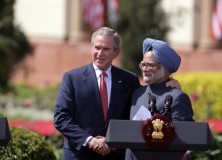U.S.-India Civil Nuclear Cooperation Agreement — Patrick Mendis and Leah Green

INTRODUCTION:
The proposed U.S.-Indian civil nuclear cooperation accord represents a transformation in American nuclear nonproliferation policy. By examining the policy shift and the security implications of the proposal, this case study illustrates the challenges of adjusting long-standing policy guidelines to conform to new strategic frameworks. It also provides insight for future interactions in which broader strategic ties and policy goals transcend traditional security issues. The key concern of the proposed U.S.-India nuclear deal—balancing nonproliferation goals with other foreign policy objectives—is one that will remain relevant with respect to India even if the nuclear agreement falls through.
STRATEGY:
In pursuing nuclear cooperation with India, the George W. Bush administration replaced an integrated, long-established strategy that emphasized nonproliferation objectives with a White House-dominated approach that circumvented typical interagency processes. Key officials reversed the Clinton policy, which sought to “cap, roll back, and eliminate” India’s nuclear program. Instead, they promoted an ad hoc approach that employed civilian nuclear cooperation as a means to strengthen U.S.-Indian relations and India’s regional power status. To this end, President Bush waived previously established sanctions stemming from India’s 1998 nuclear test. Beginning in 2001, moreover, U.S. officials engaged in successive rounds of negotiations with their Indian counterparts. Originally confined to defense and technology cooperation, U.S.-Indian discussions towards nuclear cooperation began in earnest in 2005. By March 2006, these talks had culminated in the Bush-Singh Accord, which outlined the foundation of future U.S.-Indian cooperation in civil nuclear energy and dual-use technology.
At this juncture, however, the White House encountered difficulties in its approach to Capital Hill. The administration wanted Congress to exempt India from certain Atomic Energy Act provisions and provide the executive branch with the authority to finalize the cooperation accord without additional congressional action. Yet legislators, many of whom were uncomfortable with the loosely framed provisions of the Bush-Singh agreement, responded by passing the Hyde Act, which required India and the nuclear cooperation accord to adhere to certain conditions before Congress would consider approving a finalized agreement. Though President Bush issued a Presidential Statement limiting Hyde Act restrictions, the pace of U.S.-Indian negotiations slowed and the formal text of the accord was not completed by the U.S. and Indian negotiating teams until mid-2007. The accord’s realization further depends on whether India is able to attain corresponding agreements with international non-proliferation bodies and whether Congress supports the agreement’s final terms.
INTEGRATED ELEMENTS OF NATIONAL POWER:
Influential Bush administration officials, including Robert Blackwill, Nicholas Burns, Stephen Hadley, Condoleezza Rice, and other senior policy-makers viewed India as an emerging strategic partner of the United States, including vis-à-vis China. They collaborated across the interagency to advance U.S.-Indian civil nuclear cooperation. Though some policy conflict existed within the administration, the internal dissent was minimized by constricting the decision-making circle. When disagreements did occur—for example, within interagency negotiating teams—the importance senior officials placed on achieving cooperation in a timely manner typically forced consensus. Yet, extensive executive-legislative conflict over the agreement was notable. Members of Congress expressed concerns in particular about the threat the agreement might pose to the global nuclear nonproliferation regime by, for instance, establishing loopholes for other countries to exploit. In contrast, the White House downplayed these nonproliferation risks and remained focused on the strategic importance of strengthening U.S.-Indian relations.
EVALUATION:
The decision to avoid time-consuming but comprehensive analysis at the lower levels of the U.S. foreign policy bureaucracy, the similar geopolitical perspectives of high-level policy-makers, and important personnel and organizational shifts––such as the critical appointment of Condoleezza Rice as Secretary of State––facilitated the U.S. government’s success in uniting the executive branch. Nevertheless, this approach, combined with the administration’s failure to incorporate extensive congressional consultation, has thus far failed to win over many of the deal’s opponents. Lawmakers in Washington and New Delhi still disagree sharply over their preferred approach. The lack of consultation and transparency on the part of the administration appears to have exacerbated congressional reservations regarding the proposed shift in U.S. nonproliferation strategy. Meanwhile, legislative stipulations, as specified in the Hyde Act, have complicated and delayed implementation of the accord by requiring a fragile Indian coalition government to secure approval for an agreement that contains domestically unpalatable requirements.
RESULTS:
The top-down approach of the Bush administration rapidly advanced a transformative agreement that resolved a number of deeply rooted issues that had long complicated U.S. nonproliferation policy toward India. In particular, the approach addressed the issues of safeguards and reprocessing rights, which had been the cause for three decades of U.S.-Indian recrimination. The repeated travel and other exchanges of senior officials between Washington and New Delhi have also forged a link between the two capitals. Thanks to these and other developments, an improved rapport among U.S. and Indian counterparts will likely remain intact even if the deal falls through. Nevertheless, the White House’s strategy may result in the failure to secure congressional approval of the agreement, which could inflict other costs on U.S.-Indian relations and commerce.
CONCLUSION
The case illustrates the difficulties of achieving executive-legislative agreements that entail abrupt changes in U.S. strategies on sensitive national security issues—even when these transformations may be necessary to respond to evolving international threats and opportunities. The study also highlights the tradeoff between achieving executive branch consensus by constraining decision-making and securing wider approval for the resulting policies within the broader U.S. national security system.